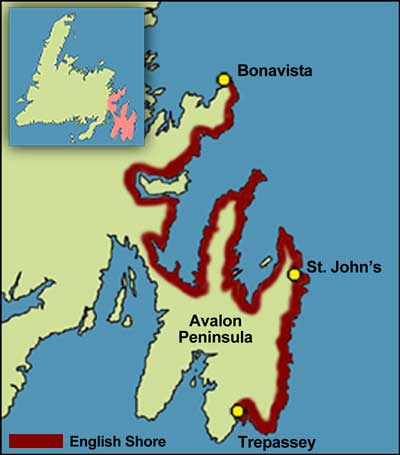Newfoundland Settlement and the Migratory Fishery
In 1620, Robert Hayman, former governor of the colony at Bristol's Hope (Harbour Grace), called the permanent settlement of Newfoundland "a business honourable, profitable, feasible, facile and opportune". It is certainly true that the colonies which were established at Cupids, Ferryland and elsewhere played an important role in the settlement of parts of the Avalon Peninsula. However, they were the exceptions. Along most of the English Shore, from Bonavista to Trepassey, the process of settlement was an informal consequence of the West Country migratory fishery.

The Question of Permanent Settlement
Whether permanent settlement should be allowed or encouraged at Newfoundland was an issue of some debate in the later 17th century. But in the late 1670s the Committee for Trade and Plantations in London finally decided that settlement should be accepted. There were those among the West Country fish merchants who disagreed, and their arguments have enjoyed a long historical after-life. Indeed, some historians have argued that successful exploitation of the Newfoundland fishery did not require settlement, and that the fishery had no place for a settled population.
However, many 17th century contemporaries thought otherwise. Their arguments in favour of settlement contain an economic logic which fits in with our current understanding of the fishery as a common property resource. From early proposals like Hayman's to the late 17th century debate on the need for government, the settlement of Newfoundland was justified, in great part, as a way to protect the British fishery.
Competition Within the Fishery
Why was such protection necessary? The fishery is, notoriously, a common property resource, that is, one which is difficult to enclose or privatize. Consequently, the territories used by fishers are not protected from interlopers by conventional property rights. Physical competition among fishers over access to the resource is therefore common. This was as true of the 17th century fishery as it is of today's fishery. The conflicts between migratory and settled fishers, often described by historians, should be seen (as they were then) as examples of a wider phenomenon: competition typical of fishers in general.
Such conflicts were not peculiar to the English Shore of Newfoundland. The French had to deal with similar problems, as did the English settlements of coastal Maine and Massachusetts. Fishing crews everywhere were capable of destroying each others' stages and stealing each others' boats. It was the economic logic of competition for an open-access resource that led fishermen to do such things.
In Newfoundland, a migratory master who could depend on a resident to protect his boats, reserve fishing rooms and preserve his stages would have a competitive advantage, even if he had to pay for it. Once one fishing master in an area had a winter caretaker, such caretakers became necessary for his competitors. Fishers who left their equipment unprotected were at the mercy of those whose boats and rooms were secure.
Even the relationship between French and English fishermen in Newfoundland can be seen in this light. If the French were to continue fishing in proximity to the permanent English settlements which developed in the mid-17th century, it was inevitable that they would set up their own colony of resident fishermen to protect their seasonal stations. This they did at Plaisance (Placentia) in 1662. Conversely, the existence of French settlement became a strong argument for the maintenance of the English fishing settlements. After the Treaty of Utrecht in 1713 banned French settlement, France's metropolitan fishermen continued to regard English settlement as an immense competitive advantage.




